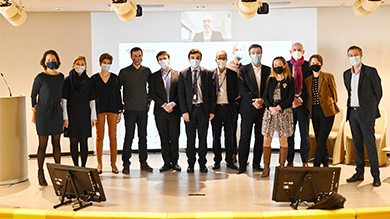The infrastructure sector is set to withstand the ongoing crisis much better than cyclical sectors, even if it is not completely immune. The crisis is unlikely to affect the sector’s strategic roadmap. Above all, it should act as a catalyst for efforts undertaken in the European Union to comply with the 2015 Paris agreement on climate change. Ivan Pavlovic, Infrastructure / Green & Sustainable specialist, Natixis CIB Research explains in further detail his analysis in this podcast.
The infrastructure sector, also known as the utilities sector, encompasses a wide range of activities in the supply of traditionally non-cyclical services, namely:
- Electricity & gas supply,
- Electricity generation from conventional as well as from renewable sources (wind and solar),
- Water supply & waste sorting/recycling.
The sector also includes a fully regulated segment, namely electricity and gas networks.
Although not a cyclical sector, utilities are not completely immune to the ongoing crisis, with impacts mainly felt through a slump in power consumption (from -15% to -25% in France, Italy and Spain since the start of the containment measures) and sorted/recycled waste volumes. In an economic environment set to remain depressed after the end of the lockdown measures across the European Union, volume trends are likely to mimic macro-economic indicators in the coming months.
At this stage, the power segment seems to be taking the hardest hit, given the abovementioned slump in power consumption. In particular, EDF now expects French power consumption to show a contraction rate as high as 20% for 2020 and accordingly has been forced to reduce its targeted nuclear output for the current year. However, looking at forward Y+1 prices in France and Germany, current levels are just a tad lower than pre-crisis levels.
However, the infrastructure sector is set to withstand the ongoing crisis much better than cyclical sectors, due to a set of five reasons:
- First, they provide essential services for a modern economy to function properly;
- Second, save for specific cases of utilities with mostly "merchant" power activities (Fortum and Uniper), the main sectoral players enjoy fairly diversified operating profiles as well as a fairly high share (from 20% to 80%) of revenues from regulated / LT contracted activities;
- Third, regulated network activities enjoy pass-through mechanisms, insulating them from the financial implications of electricity and gas consumption fluctuations;
- Fourth, they can respond to deteriorated fundamentals through a series of actions, in particular dividends, opex and capex cuts;
- Fifth, they enjoy access to capital markets even in the most distressed times.
All in all, save for specific individual situations, we expect the sector's EBITDA contraction in 2020 to be limited to a range of -5% to -10%.
Going forward, what could be the implications on the infrastructure sector of the ongoing crisis?
We believe that whilst having adverse impacts on players' cash flow generation, the crisis is unlikely to affect the sector's strategic roadmap. Before the crisis broke out, most if not all industry players had embarked on massive transformation plans matching EU countries' energy transition policies and decarbonization efforts. Over the past five years, utilities' capex programs have heavily revolved around development of renewable capacities and expansion and digitization of networks; in the electricity sector, the purpose of these network investments is to smooth the integration of incremental renewable generation capacity; in the gas sector, there is a recent but growing set of initiatives aimed at integrating low-carbon gases such as biomethane and hydrogen into existing gas infrastructures.
Against this backdrop, the crisis may act as a catalyst for the EU as a whole and individual member states at their level to intensify their efforts to achieve carbon neutrality by 2050, which is a key condition to fullfil the 2015 Paris agreement on climate change. This is the main purpose of the Green deal unveiled last December by European Commission President Ursula von Der Leyen. In the current Covid-19 dominated context, the perspective of this Green Deal would be twofold:
- First, fuel the European Union economy's recovery, through funding of large-scale investments and support of native European industries.
- Second, accelerate the abovementioned transition towards a zero-carbon economy. Avenues pursued to achieve this transition primarily include:
- Continued expansion of renewable energies and increased used of electricity as a decarbonization agent in particular in the transportation sector;
- Development of green hydrogen as a substitute for coal, gas and oil, either as a feedstock or as an energy vector in hard to abate sectors such as steel manufacturing and transportation.














